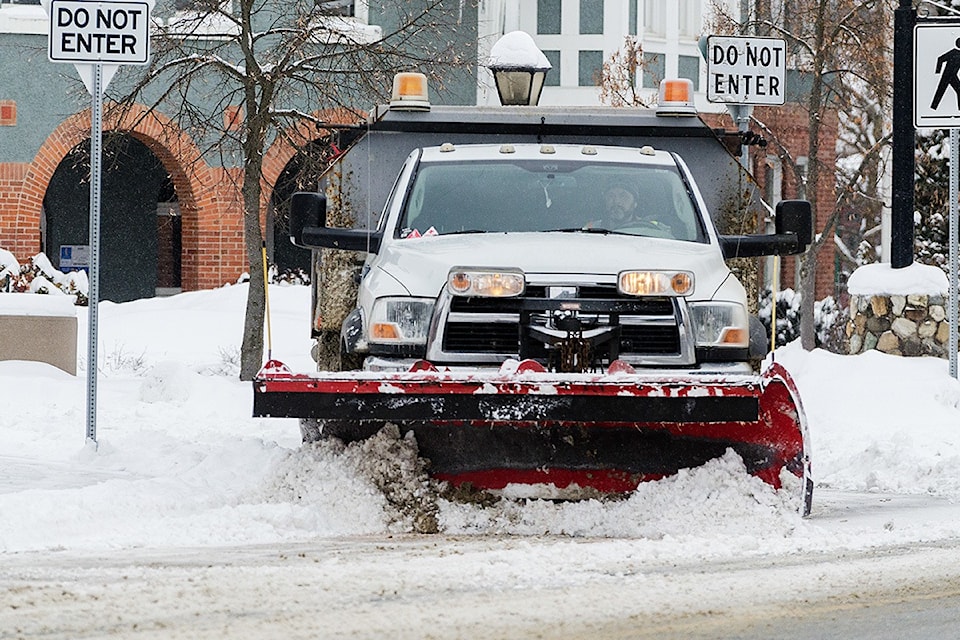The City of Salmon Arm will be looking for more funds for snow removal as the majority of this year’s budget was exhausted within the first two months.
Rob Niewenhuizen, the city’s director of engineering and public works, estimates Salmon Arm received about 35 per cent more snow this winter than what it normally receives. As a result, he said the city has already spent about 87 per cent of the year’s total budget for snow and ice control (approximately $750,000 for roads and $120,000 for sidewalks).
As Niewenhuizen says, this doesn’t leave much for November and December. This leaves public works with a few options for November/December, including going over budget if needed and amending the budget in December, or seeking a budget increase with an amendment before winter returns.
“I would prefer to make sure everybody is aware of where our budgets are sitting now so they know we’re going to have some issues in the fall,” said Niewenhuizen. “Because we already know we don’t have enough money in these budgets currently to finish off the fall work
“The issue is we have to find the money for it, and that could be anything from taking a project, one of our capital works projects, offline and postponing it to next year and using those funds to help fund snow removal, or looking at some reserve… that’s up to finance.”
Niewenhuizen will likely outline the budget situation in a report requested by Coun. Ken Jamieson and council at their Feb. 26 meeting. Responding to recent public complaints about snow clearing and related challenges, Jamieson said the city’s current snow removal policy has been in place for about nine years.
RELATED: Complaints mount with snow piles
RELATED: Public pans snow clearing in Shuswap
“Things have changed, there’s more streets, more subdivisions, more challenges, and I’m just wondering if there’s a way we can look at what we’re doing and if there’s things that we can maybe improve, or things that we’re doing good already,” said Jamieson.
That policy currently prioritizes arterial and collector routes (30th Street and Okanagan Avenue), hospital and bus routes, school zones and severe hills, with contractors looking after the downtown overnight. Subdivisions are further down the list of priorities, as are no-through roads and cul-de-sacs.
But Niewenhuizen says he and staff have, at times, worked around that policy to address the heavy snowfall and the needs of the community.
“We follow the policy the best we can, but if we have a heavy snowfall, that’s not going to stop us from sending a truck into certain subdivisions to clear a path, to clear a road,” said Niewenhuizen. “It may not be a full-blown clean out, but at least it opens up a road so people can access it.”
That said, Niewenhuizen explained how during times of heavy snowfall, the city’s rotating crew of 12 will work on arterial and collector routes and, by the time they’re done, will have to start on them again.
Asked if his report to council might take into account changing climate and increased precipitation, Niewenhuizen said it’s definitely something the city has to consider, but is difficult to budget for. He noted last year’s unusual weather that created a different series of challenges, from rapidly melting snow that led to flooding and damaged roads, to windstorms knocking down trees to the lake rising and further flooding.
“There’s obviously some rationale for trying to adapt to climate change – I don’t know how you budget for that,” said Niewenhuizen.
While weather and growth in residential areas may necessitate amending the city’s snow maintenance policy, Niewenhuizen anticipates changes will be limited.
“I don’t think the policy will change too much – I don’t suspect it will,” said Niewenhuizen. “It’s more about looking at what we have for resources and really it’s up to council to decide what level of service they want to provide, and that’s based on the finances of it.”
@SalmonArm
lachlan@saobserver.net
Like us on Facebook and follow us on Twitter
